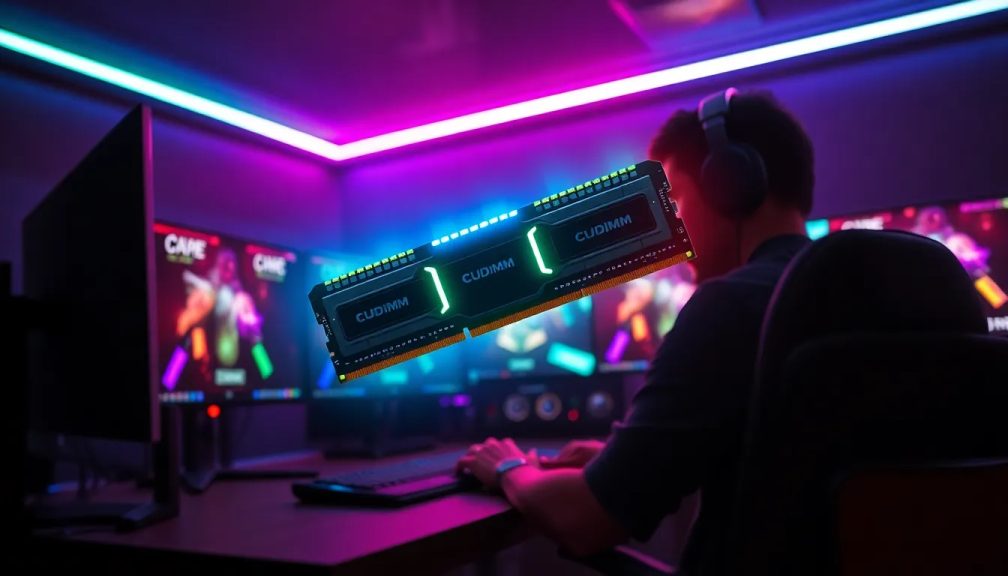Why CUDIMM is essential for overclockers and PC gamers

The world of PC hardware is constantly evolving, and memory technology is no exception. This evolution is perhaps most evident with the introduction of CUDIMMs, a new standard poised to transform how we think about memory in high-performance computing. This article will explore what CUDIMMs are, how they differ from traditional memory modules, and why they are becoming essential for overclockers, gamers, and DIY PC builders alike.
As technology progresses, the components that once seemed static are now undergoing revolutionary changes. With the arrival of CUDIMMs, we are witnessing a significant leap forward in memory capabilities that enthusiasts and gamers cannot afford to ignore.
Understanding CUDIMMs and Their Functionality
The term CUDIMM stands for Clocked Unbuffered Dual Inline Memory Modules. These modules represent a notable advancement over the conventional UDIMMs (Unbuffered Dual Inline Memory Modules), primarily through the incorporation of a new clock driver chip. This innovation enhances the signal from the CPU’s onboard memory controller, significantly improving signal integrity and system stability.
Here are the key features of CUDIMMs:
- Clock Driver Chip: This component boosts the signal integrity, ensuring better synchronization across memory chips.
- Improved Stability: The enhanced signal integrity reduces clock jitter, which is crucial for maintaining performance at higher frequencies.
- Dynamic Voltage Adjustments: CUDIMMs can adjust voltages as needed, which helps maintain operational efficiency.
- Higher Frequencies: These modules can achieve speeds previously unattainable with standard UDIMMs.
As the demand for faster and more efficient memory continues to grow, CUDIMMs are set to become a staple in high-performance systems, catering to gamers and professionals who depend on speed and stability.
Faster Performance: A New Benchmark in Memory
The introduction of DDR5 RAM was a game changer, effectively doubling the performance of its DDR4 predecessors. With the advent of CUDIMMs, we are now looking at even greater improvements. The clock driver chip helps to recondition the timing and voltage signals from the memory controller, which enhances synchronization and overall performance.
CUDIMMs are designed to push the limits of what is possible with memory technology. Here’s how they achieve these remarkable speeds:
- Signal Conditioning: The clock driver chip optimizes the signals for each memory chip, ensuring they operate in harmony.
- Reduced Clock Jitter: This leads to greater signal integrity, essential for ultra-high-speed memory performance.
- New Frequency Standards: Manufacturers can now produce chips that operate at frequencies exceeding previous limitations.
For example, Biwin’s new line of CUDIMM memory can reach speeds of up to 9,200 MT/s, a significant leap from the already impressive DDR5-8400. This level of performance is especially beneficial for gaming and intensive applications, where every millisecond counts.
Efficiency and Temperature Management
One of the standout features of CUDIMMs is their efficiency. While DDR5 was designed to operate at a voltage of 1.1V, many overclocked modules have required higher voltages, leading to increased power consumption and heat generation. CUDIMMs, however, are pushing efficiency back into the spotlight.
With a built-in Power Management Integrated Circuit (PMIC), CUDIMMs can dynamically adjust voltage levels, ensuring optimal performance without the excessive heat commonly associated with overclocking. This design contributes to:
- Lower Operating Temperatures: By maintaining lower voltages, CUDIMMs help keep system temperatures down.
- Enhanced Longevity: Operating cooler extends the lifespan of both the memory modules and the overall system.
- Improved Power Efficiency: Users can enjoy higher performance without a corresponding spike in energy usage.
These benefits lead to a more stable and efficient system, which is a significant advantage for those pushing their hardware to the limits.
Compatibility and Current Limitations
While the benefits of CUDIMMs are substantial, their current compatibility landscape presents some limitations. At present, the primary beneficiaries of this new technology are Intel users. The latest Intel Arrow Lake processors, particularly those on Z890 motherboards, fully support the CUDIMM standards, allowing users to unlock the full potential of their memory.
In contrast, AMD users may find themselves at a disadvantage. Although the latest Ryzen platforms on X870 motherboards can utilize CUDIMMs, they often operate in "Bypass" mode, which does not leverage the full advantages of the clock driver technology. Users can still manually overclock their systems, but this requires a deeper understanding of memory clock ratios and infinity fabric balancing.
To summarize the current landscape:
- Intel Platforms: Fully support CUDIMMs and can operate at optimized speeds.
- AMD Platforms: Limited to Bypass mode; full benefits require manual adjustments.
- Overclocking Needs: Users must balance memory clock ratios for optimal performance on non-Intel systems.
Conclusion: A Look Ahead for Memory Technology
The introduction of CUDIMMs is a pivotal moment for memory technology, offering revolutionary improvements in speed, efficiency, and stability. As we move into 2025, these modules are expected to become standard in high-performance PCs, reflecting the ever-evolving demands of gamers, overclockers, and DIY builders. For those keen to stay ahead of the curve, considering an upgrade to CUDIMMs is a step in the right direction.
For more information on the performance benefits of CUDIMMs, check out this video that explains the technology further:




Leave a Reply